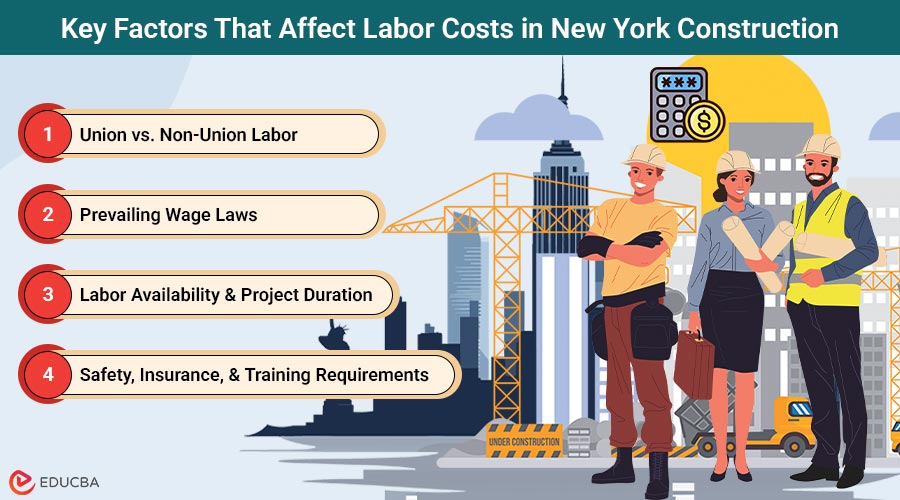
How Do Labor Costs in New York Impact Your Construction Budget?
Labor is one of the biggest expenses in any construction project, especially in New York. From union wages and safety laws to labor shortages and training requirements, these factors can significantly affect your total budget. Whether you are building a house in Westchester or a high-rise in Manhattan, understanding labor costs in New York is crucial for staying on budget and avoiding delays.
Why Labor Costs Matter More in New York?
Labor costs in New York are often much higher than the national average. In fact, they can make up 30% to 50% of your total construction budget. This is higher than the national average, largely due to:
- Prevailing wage laws
- High unionization rates
- Cost of living adjustments
- Strict safety and training regulations
Key Factors That Affect Labor Costs in New York Construction
Several important elements influence how much you will pay for labor in New York construction projects. Below are the main points to consider:
1. Union vs. Non-Union Labor
Union Labor (Primarily NYC and Large Projects):
- Higher hourly rates (often $75–$150/hour with benefits)
- More specialized workers for each trade
- Strict work rules and jurisdictional agreements
- Required on many public or large-scale private developments
Non-Union or Open-Shop Labor (Common Upstate & Small Jobs):
- More affordable (often $40–$80/hour)
- Greater flexibility in task-sharing
- Faster decision-making on-site
Impact: Choosing union labor can increase your total labor costs by 20–35%, but may improve quality, safety, and compliance, especially in complex builds. A NYC estimating services company helps you with that.
2. Prevailing Wage Laws
In NYC and much of the state, public and publicly funded construction projects require contractors to pay prevailing wages set by the NYS Department of Labor.
These rates include:
- Base wages
- Health & welfare benefits
- Pension contributions
- Holiday and overtime pay
Example: A carpenter in NYC might earn:
- $58.37/hour base wage
- $46.86/hour in supplemental benefits
That is over $105/hour—even before overtime.
Impact: Prevailing wage can add 30–40% to your labor budget compared to private, non-union work.
3. Labor Availability & Project Duration
Skilled labor shortages mean higher pay to attract qualified workers, especially for mechanical, electrical, and plumbing (MEP) trades. Delays in labor availability can extend project timelines, increasing costs for:
- General conditions (site management, equipment)
- Financing (interest payments)
- Insurance and permits
Impact: A 1-month delay on a mid-sized NYC job could cost $50,000–$250,000, depending on the scope.
4. Safety, Insurance, and Training Requirements
New York’s construction laws—especially in NYC—require:
- OSHA 30 certification for all workers
- Site safety training
- Scaffold Law (Labor Law 240/241), which makes contractors and owners liable for certain accidents
These factors:
- Increase hiring and insurance costs
- Require more supervision (site safety managers, forepersons)
- May result in higher workers’ comp premiums
Impact: Insurance and training costs tied to labor can add 5–10% to total project costs.
How Labor Costs Affect Per-Square-Foot Prices?
Here is how labor can affect per-square-foot construction costs, based on 2024–2025 data:
| Project Type | NYC Labor Share | Upstate Labor Share |
| Single-family home | $100–$150/sf | $50–$80/sf |
| Mid-rise residential | $120–$200/sf | $80–$120/sf |
| Commercial/office | $140–$250/sf | $90–$140/sf |
Budgeting Tips to Manage Labor Costs
- Plan staffing early: Secure trade contractors during pre-construction to avoid schedule slips.
- Use experienced local GCs: They have relationships with union locals or trusted subcontractors.
- Consider modular or prefab: Reduce on-site labor needs by building off-site.
- Factor in overtime & contingency: Labor costs fluctuate; build in a 10–15% cushion.
- Understand compliance: Know if prevailing wage or union labor is mandatory for your project.
Final Thoughts
Labor costs in New York are a major factor in determining your construction project’s success. With high wages, strict compliance requirements, and varying union involvement, labor is not just another expense—it is a key driver of your timeline, quality, and budget. Smart planning, early contractor engagement, and awareness of regional labor rules can help you stay on schedule and avoid costly surprises. When it comes to building in New York, managing labor costs the right way can mean the difference between profit and problems.
Recommended Articles
We hope this guide on labor costs in New York helps you better understand how wages, regulations, and union standards impact your construction or business budget. Explore these recommended articles for more insights on managing costs and improving project efficiency.
- Labor Cost
- Gross Wages
- Project Budgeting
- Construction Management Strategies



